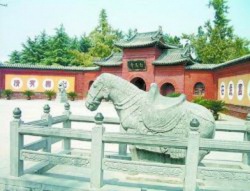Difference between revisions of "Kāśyapa, Mātaṅga and Dharmaratna"
| Line 1: | Line 1: | ||
[[File:Kasyapa.jpg|thumb|250px|]] | [[File:Kasyapa.jpg|thumb|250px|]] | ||
| − | [[Kāśyapa]] Mātaṅga and Dharmaratna were, according to {{Wiki|ancient}} [[tradition]], the [[Indian]] [[monks]] who first introduced [[Buddhism]] into [[China]]. It is said that the [[Emperor]] [[Ming]] (58-75 CE) had a [[dream]] in which a golden {{Wiki|image}} appeared in the {{Wiki|west}}. So moved was he by this [[strange]] [[dream]] that he sent a group of envoys [[beyond]] the western borders of [[China]] to find out what they could about this {{Wiki|image}}. This was in about 64 CE. The envoys returned three years later accompanied by two [[monks]], [[Kāśyapa]] Mātaṅga and Dharmaratna. The [[monks]] brought with them a text called The [[Sūtra]] of the Forty-Two [[Sections]] and the [[emperor]] built them a [[monastery]] called The White [[Horse]] [[Monastery]], after the [[horse]] that had carried the text and the [[monks]]’ supplies. The [[Sūtra]] of the Forty-Two [[Sections]] is a collection of the [[Buddha’s]] sayings, paraphrased and arranged according to [[subject]]. It is not an [[Indian]] work but was probably compiled in {{Wiki|Central Asia}} or {{Wiki|Afghanistan}} as a brief introduction to [[Buddhism]]. It has remained popular in [[China]] right up to today. The White [[Horse]] [[Monastery]], much rebuilt and renovated over the centuries, can still be seen in Loyang, the {{Wiki|ancient}} {{Wiki|capital}} of [[China]]. | + | [[Kāśyapa]] Mātaṅga and [[Dharmaratna]] were, according to {{Wiki|ancient}} [[tradition]], the [[Indian]] [[monks]] who first introduced [[Buddhism]] into [[China]]. It is said that the [[Emperor]] [[Ming]] (58-75 CE) had a [[dream]] in which a golden {{Wiki|image}} appeared in the {{Wiki|west}}. So moved was he by this [[strange]] [[dream]] that he sent a group of envoys [[beyond]] the [[western]] borders of [[China]] to find out what they could about this {{Wiki|image}}. This was in about 64 CE. The envoys returned three years later accompanied by two [[monks]], [[Kāśyapa]] Mātaṅga and [[Dharmaratna]]. The [[monks]] brought with them a text called The [[Sūtra]] of the Forty-Two [[Sections]] and the [[emperor]] built them a [[monastery]] called The White [[Horse]] [[Monastery]], after the [[horse]] that had carried the text and the [[monks]]’ supplies. The [[Sūtra]] of the Forty-Two [[Sections]] is a collection of the [[Buddha’s]] sayings, paraphrased and arranged according to [[subject]]. It is not an [[Indian]] work but was probably compiled in {{Wiki|Central Asia}} or {{Wiki|Afghanistan}} as a brief introduction to [[Buddhism]]. It has remained popular in [[China]] right up to today. The White [[Horse]] [[Monastery]], much rebuilt and renovated over the centuries, can still be seen in [[Loyang]], the {{Wiki|ancient}} {{Wiki|capital}} of [[China]]. |
{{R}} | {{R}} | ||
[http://www.buddhisma2z.com/content.php?id=210 www.buddhisma2z.com] | [http://www.buddhisma2z.com/content.php?id=210 www.buddhisma2z.com] | ||
Latest revision as of 07:17, 23 February 2015
Kāśyapa Mātaṅga and Dharmaratna were, according to ancient tradition, the Indian monks who first introduced Buddhism into China. It is said that the Emperor Ming (58-75 CE) had a dream in which a golden image appeared in the west. So moved was he by this strange dream that he sent a group of envoys beyond the western borders of China to find out what they could about this image. This was in about 64 CE. The envoys returned three years later accompanied by two monks, Kāśyapa Mātaṅga and Dharmaratna. The monks brought with them a text called The Sūtra of the Forty-Two Sections and the emperor built them a monastery called The White Horse Monastery, after the horse that had carried the text and the monks’ supplies. The Sūtra of the Forty-Two Sections is a collection of the Buddha’s sayings, paraphrased and arranged according to subject. It is not an Indian work but was probably compiled in Central Asia or Afghanistan as a brief introduction to Buddhism. It has remained popular in China right up to today. The White Horse Monastery, much rebuilt and renovated over the centuries, can still be seen in Loyang, the ancient capital of China.
